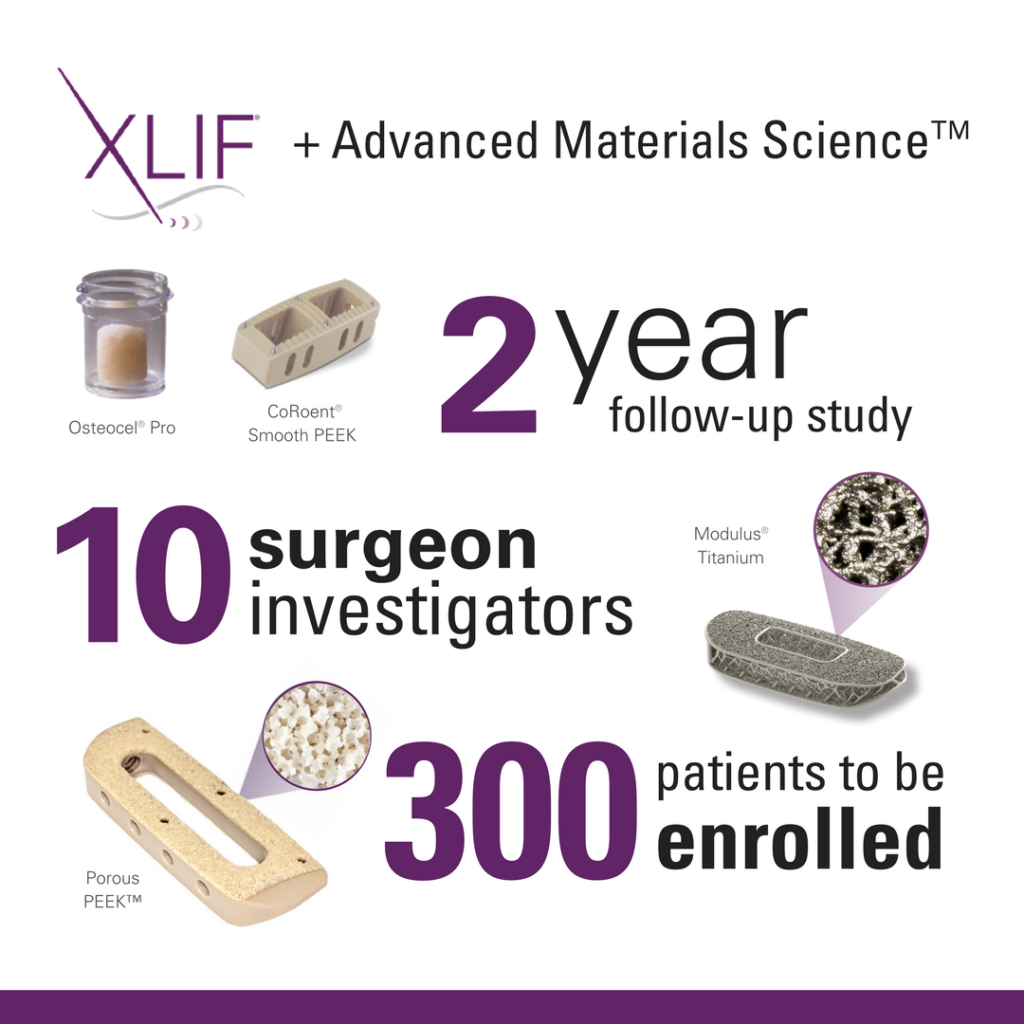![]()
At NuVasive®, research is an integral part of our business. As a sign of our commitment to research, we have a team dedicated to study operations, data collection, analytics, and clinical output. As thought leaders in spine, our history and support of research and improving patient outcomes is demonstrated by:
- More than 65 NuVasive-sponsored clinical studies completed or in-progress
- We have supported more than 100 individual surgeons and/or institutions with their research and publications
- More than 500 peer-reviewed papers on our products/procedures
We are excited to share the latest study on Advanced Materials Science™ (AMS) and biologics to begin enrolling early this year—A prospective multicenter study evaluating the effect of implant material and/or surface structure on progression of fusion in XLIF® surgery.

With the launch of our Advanced Materials Science portfolio, we are undertaking this study to evaluate and compare the clinical and radiographic outcomes of CoRoent® smooth PEEK, Modulus® 3D-printed titanium, and Porous PEEK™ interbody implants when used with Osteocel® Pro or cancellous allograft chips and bone marrow aspirate in subjects who undergo XLIF surgery at one or two levels.
Meet Kyle and Rebecca from the Clinical Resources Team who will share more about our commitment to research, why it is important, and what is ahead.

Why is research important and how is NuVasive leading the way?
Becca: Research and data collection are critical to better understanding how our procedures perform in the hands of our surgeon partners and allow us to evaluate patient outcomes in a way that can influence the quality of care our patients receive. NuVasive has been committed to research since day one and continues to be an industry leader with ongoing sponsored studies and data collection efforts with the SpineTRACK Registry.
What are some notable studies that NuVasive has been a part of?
Kyle: All of our studies have played a key role in driving innovation and improving quality of care, but I will highlight a few that really stand out and speak to our lateral focus and leadership.
We have completed and published on a series of neuromonitoring studies including our Dilator study, Center Blade study, and more recently the TMAP™ study—validating the use of various neuromonitoring modalities of NVM5® for reproducible outcomes in lateral access spine surgery (XLIF).
Our XLIF adult scoliosis study, published in Spine, was instrumental in demonstrating the use of the XLIF procedure in the treatment of degenerative scoliosis. This study concluded that XLIF is associated with good clinical and radiographical outcomes, with a substantially lower complication rate than has been reported with traditional surgical procedures.
And, the XLIF vs. TLIF study, published as a series of articles in Spine in 2016 (Sembrano, et al. and Isaacs, et al.), concluded that despite different mechanisms of action (indirect vs. direct decompression), mid-term clinical outcomes between XLIF and MIS TLIF were similar in the treatment of lumbar degenerative pathology. This helped us validate that indirect decompression with the XLIF procedure is a viable solution and also provided important data in support of our MAS TLIF procedure.
Stay tuned for more information about our iGA studies and the importance of alignment.
How will this new Advanced Materials Science study help patients, the medical community, and NuVasive?
Becca: We are thrilled to launch this new XLIF study which will allow us to explore different implant surface characteristics and procedural combinations afforded through our Advanced Materials Science portfolio. We will not only be able to look at how these advanced technologies paired with market-leading graft options can lead to better patient outcomes, but also evaluate cost, efficiency, and impact to our hospital partners. Ultimately, our aim is to realize the shared goal of helping improve the overall quality of care.
Any insight you can share on the future of research and data collection efforts at NuVasive?
Kyle: In alignment with our strategy and evolution to systems-based spine solutions, there will be an expanded focus on optimizing the delivery of care through data aggregation and insights. We’ll continue to bring new services to our surgeon partners to help them deliver optimal results to the patients that they treat.
1 Tohmeh AG, Rodgers WB, Peterson, MD. Dynamically evoked, discrete-threshold electromyography in the extreme lateral interbody fusion approach. J Neurosurg Spine 2011;14(1):31-7.
2 Uribe JS, Isaacs RE, Youssef JA, et al. Can triggered electromyography monitoring throughout retraction predict postoperative symptomatic neuropraxia after XLIF? Results from a prospective multicenter trial. Eur Spine J 2015;24(3):378-85.
3 Phillips FM, Isaacs RE, Rodgers WB, et al. Adult degenerative scoliosis treated with XLIF: clinical and radiographical results of a prospective multicenter study with 24-month follow-up. Spine 2013;38(21):1853-61.
4 Sembrano JN, Tohmeh AG, Isaacs RE, et al. Two-year comparative outcomes of MIS lateral and MIS transforaminal interbody fusion in the treatment of degenerative spondylolisthesis: Part I Clinical findings. Spine 2016;41(1):S123-32.
5 Isaacs RE, Sembrano JN, Tohmeh AG, et al. Two-year comparative outcomes, MIS lateral and MIS transforaminal interbody fusion in the treatment of Degenerative Spondylolisthesis: Part II Radiographic findings. Spine 2016;41(1)S133-44.